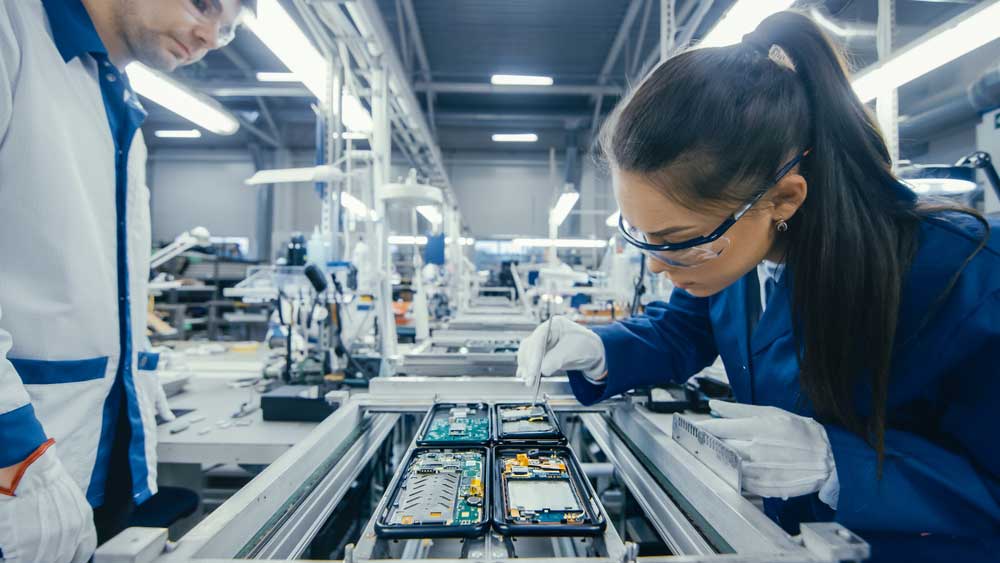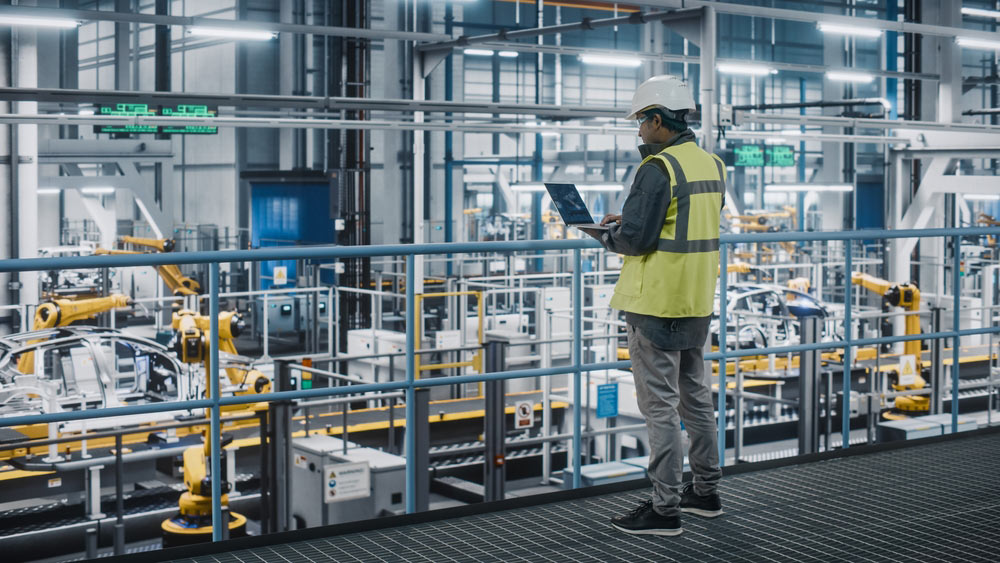Manufacturing production stands as the backbone of economic vitality, a silent yet powerful engine driving the progress of nations. It’s the process that transforms raw materials into finished goods, ready to meet the demands of global markets. This sector is not just about assembly lines and machinery; it’s a complex ecosystem that encompasses the latest in technology, workforce skills, and economic trends.
In the tapestry of the modern economy, manufacturing weaves a critical thread. It’s a sector characterized by its ability to adapt, innovate, and generate wealth. Historically, the strength of a nation’s manufacturing capabilities has been a barometer for its economic health. Today, this remains true as manufacturing contributes significantly to the Gross Domestic Product (GDP) of countries, signaling its undiminished importance in the age of information and service economies.
The narrative of manufacturing production is one of constant evolution. The advent of the Fourth Industrial Revolution, marked by the fusion of digital technologies with the physical world, has reshaped the manufacturing landscape. Robotics, the Internet of Things (IoT), and artificial intelligence (AI) are no longer futuristic concepts but everyday tools that enhance efficiency and productivity on the manufacturing floor.
Yet, the sector is not without its challenges. The fluctuating tides of trade policies, the push for sustainable practices, and the unpredictable shifts in consumer demand all play their part in shaping the manufacturing narrative. Companies and workers alike must navigate these waters with agility and foresight.
The current state of manufacturing production is a study in resilience. Despite the headwinds of economic downturns and the recent global disruptions, the sector has shown a capacity for recovery and growth. Data from economic sources reflect a cautious optimism, with manufacturing production inching forward, even in the face of adversity. This resilience is not just a testament to the sector’s robustness but also to the innovation and determination of those who keep the wheels of production turning.
As we delve deeper into the specifics of manufacturing production, we uncover a landscape marked by diversity. From the production of consumer electronics to the fabrication of industrial machinery, each niche has its own set of dynamics. The production lines that assemble automobiles are vastly different from those that produce pharmaceuticals, yet they all share the common goal of creating value through transformation.

The educational pathways into manufacturing are as varied as the sector itself. While some roles demand the technical expertise that comes with higher education and specialized training, others are accessible through apprenticeships and on-the-job learning. The key is a willingness to learn and adapt, qualities that are indispensable in an industry characterized by continual change.
In terms of compensation, manufacturing production offers a wide spectrum of salary ranges. Factors such as geographical location, level of expertise, and the specific industry segment all play a role in determining earnings. However, one constant remains: the potential for career progression. With experience and additional training, individuals in this field can ascend to roles of greater responsibility and, consequently, higher remuneration.
The skill set required for success in manufacturing production is evolving. Traditional skills like machine operation and assembly are now augmented by digital literacy and proficiency in advanced technologies. Employers are on the lookout for workers who can navigate the interface between the digital and the physical, those who can manage automated systems as comfortably as they handle traditional tools.
Looking ahead, the future of manufacturing production is one of transformation. As companies invest in smart factories and data-driven production processes, the opportunities for innovation and growth are boundless. The manufacturing professional of tomorrow will need to be as adept in digital skills as they are in mechanical acumen.
The Manufacturing Production Landscape
The manufacturing sector, a vital engine of global economies, is undergoing a seismic shift. With the advent of Industry 4.0, the production floors that once buzzed with the sounds of manual machinery are now humming with automated systems and digital processes. This transformation is not just a change in the physical equipment but a complete overhaul of the manufacturing ethos.
The Digital Revolution in Manufacturing
The digital revolution has ushered in an era of smart manufacturing where big data, AI, and the Internet of Things (IoT) converge to create systems that are interconnected and intelligent. The adoption of these technologies has led to a significant increase in productivity. For instance, a study by the World Economic Forum highlighted that over 70% of businesses that adopted advanced manufacturing technologies saw a 5-20% increase in productivity.
Automation and Job Dynamics
Contrary to the popular belief that automation leads to job losses, the narrative within the manufacturing sector is nuanced. While automation does replace certain manual jobs, it also creates new roles that require more advanced skills. According to the Manufacturing Institute, there will be an estimated 2.1 million unfilled manufacturing jobs by 2030, primarily due to skill gaps in the evolving technological landscape.
Statistical Snapshot of Manufacturing Production
Recent data from the Federal Reserve indicates that manufacturing output has seen a marginal rise. In August, there was a reported 0.1% increase in factory output, a figure that, while modest, reflects the sector’s resilience in the face of economic headwinds. This is in stark contrast to the 0.6% year-on-year decrease, showcasing the volatility and the gradual recovery of the sector.
Economic Indicators and Future Outlook
The manufacturing sector’s capacity utilization, a key indicator of economic health, stood at 77.9% in August, just 0.3 percentage points below its long-run average. This suggests that the sector is operating near its potential, which is a positive sign for future growth. Moreover, the Institute for Supply Management’s index indicated that while factory activity contracted for the 10th consecutive month, the pace of decline is slowing, hinting at potential stabilization.
The Global Manufacturing Index
On a global scale, the United Nations Industrial Development Organization (UNIDO) reports that the World Manufacturing Production index saw a quarter-on-quarter increase of 3.6% in the second quarter of 2023. This reflects a gradual but steady recovery from the downturn caused by the pandemic.
The Human Factor
Despite the surge in technology, the demand for skilled human labor remains high. The National Association of Manufacturers (NAM) reports that over the next decade, manufacturers will need to fill 4.6 million jobs. These roles are increasingly complex, requiring a blend of technical know-how and problem-solving skills.
Job Outlook and Market Analysis For Manufacturing Production Workers
The manufacturing sector, once the powerhouse of job creation and economic stability, has been navigating through a sea of changes, influenced by economic shifts, technological advancements, and global market pressures.
The current job outlook in manufacturing production is a tale of cautious optimism. Despite the challenges posed by automation and offshoring, there is a steady demand for skilled workers who can manage and work alongside advanced machinery and software. The United States Bureau of Labor Statistics (BLS) projects that employment in manufacturing will experience a slower rate of decline between 2019 and 2029 compared to the previous decade. This is a significant indicator of stabilization within the sector, suggesting a shift from the steep declines seen in the early 2000s.

However, this stabilization does not imply a uniform spread of opportunities across the sector. Certain sub-sectors within manufacturing are poised for growth, driven by innovation and domestic demand. For instance, the aerospace, biotechnology, and energy sectors are expected to see an uptick in production roles. Conversely, traditional sectors like textile and apparel manufacturing may continue to face headwinds due to competitive labor markets overseas.
Economic factors play a pivotal role in shaping the job outlook for manufacturing production. Interest rates, for example, have a direct impact on consumer spending and business investment—two drivers of manufacturing demand. The Federal Reserve’s adjustments to the benchmark interest rate can either stimulate growth by making borrowing cheaper or dampen it by doing the opposite. As of the latest reports, the Fed’s hawkish stance to curb inflation has raised concerns about a potential cooling effect on manufacturing production and employment.
The manufacturing industry is not just contending with domestic economic policies but also with global economic dynamics. Trade policies, tariffs, and international relations can either open up new markets or restrict access, thereby affecting production volumes and workforce needs. The recent trade tensions and subsequent agreements have reshaped supply chains, sometimes bringing production back to domestic shores, a trend known as reshoring, which could bode well for the job market.
Salaries in manufacturing production vary widely, influenced by factors such as geographic location, level of experience, and the specific industry segment. For instance, production managers in the pharmaceutical industry may command higher salaries due to the stringent regulatory environment and the complex nature of pharmaceutical production. On the other hand, entry-level positions in more traditional manufacturing settings may offer lower starting wages, reflecting the differing levels of skill and education required.
The manufacturing sector also presents a unique set of challenges and opportunities. The push for sustainability and the adoption of green manufacturing practices have opened new avenues for innovation and employment. Professionals who can navigate the complexities of eco-friendly production processes are in demand. Additionally, the industry’s drive toward increased efficiency and waste reduction has spurred the need for continuous improvement specialists, quality control experts, and logistics analysts.
Salary Expectations and Progression
In the realm of manufacturing production, salary is a pivotal factor that not only influences career choices but also reflects the industry’s value in the economy. Professionals in this field can expect their earnings to be aligned with their level of expertise, geographical location, and the specific sector of manufacturing they are engaged in.
According to the Bureau of Labor Statistics, the mean annual wage for Food Batchmakers, a role within the manufacturing production sector, stands at approximately $38,710 as of May 2022. This figure is a baseline within the manufacturing industry, with variations occurring based on several influencing factors.

Salary Variations Across the Industry
The manufacturing sector is diverse, encompassing everything from food production to high-tech manufacturing. Within this spectrum, salaries can vary significantly. For instance, those working in the Other Food Manufacturing sector have an average annual wage of $38,460, while professionals in Dairy Product Manufacturing can earn an average of $43,630 annually.
Geographical Impact on Salaries
Location plays a crucial role in salary determination. For Food Batchmakers, states like Wisconsin and California offer higher employment levels with mean wages of $41,840 and $40,120 respectively. This regional variation is often due to the cost of living, the concentration of manufacturing plants, and state-specific industry demands.
Top Paying States and Metropolitan Areas
The top paying states for Food Batchmakers, which can be seen as a subset of the broader manufacturing production roles, include Virginia, Michigan, and Missouri, with average annual wages ranging from $41,420 to $43,320. Metropolitan areas also show a range of salaries with Battle Creek, MI, and Cedar Rapids, IA, leading the pack with average annual wages of $61,260 and $59,440 respectively.
Skill Level and Salary Progression
As with most careers, the level of skill and experience has a direct impact on earning potential. Entry-level positions in manufacturing may start at the lower end of the pay scale, but with the acquisition of specialized skills, certifications, and experience, professionals can see a significant increase in their earnings. The progression from an entry-level role to a more specialized position such as a Production Manager or a Quality Assurance Specialist can lead to a substantial salary increase.
The Future of Manufacturing Salaries
The manufacturing industry is at a pivotal point with the integration of advanced technologies such as automation and artificial intelligence. These advancements are not only transforming production processes but also the skill sets required for manufacturing roles. As the demand for tech-savvy professionals increases, the salary scales are expected to adjust to reflect the higher level of expertise required.
Educational Pathways to a Career in Manufacturing Production
The journey to a career in manufacturing production often begins with a solid educational foundation. In an industry that’s rapidly evolving with technology and new methodologies, the educational requirements are becoming more stringent, reflecting the need for a workforce that’s not only skilled but also adaptable.
At the core, a high school diploma or equivalent is the minimum requirement for entry-level positions in manufacturing production. However, as the complexity of manufacturing processes increases, so does the demand for advanced education and training. Many roles now require post-secondary education, typically a two-year associate degree in manufacturing technology, engineering, or a related field. These programs offer a blend of theoretical knowledge and practical skills, covering topics like production design, operations management, and quality control.

For those aiming for more specialized or advanced positions, a bachelor’s degree in industrial engineering, mechanical engineering, or manufacturing engineering provides a competitive edge. These four-year programs delve deeper into the principles of design, analysis, and management of the manufacturing process. They also often include opportunities for internships or cooperative education, allowing students to gain hands-on experience in a real-world setting.
Beyond formal degrees, certifications can play a pivotal role in career advancement. Certifications from recognized bodies like the American Society for Quality (ASQ) or the Manufacturing Skill Standards Council (MSSC) validate a professional’s skills and knowledge in specific areas such as Lean Manufacturing, Six Sigma, or Certified Production Technician (CPT). These credentials are highly regarded by employers and can significantly enhance a candidate’s job prospects and potential salary.
Continuing education is also a critical component for career progression in manufacturing production. As technologies such as automation, robotics, and artificial intelligence become integral to manufacturing processes, ongoing learning is essential. Professionals must stay abreast of the latest developments and be willing to upskill or reskill as needed. Workshops, seminars, and online courses are increasingly available and necessary for those who wish to remain relevant in their field.
The investment in education is reflected in the potential earnings and career stability in the manufacturing sector. According to the Bureau of Labor Statistics, manufacturing workers with an associate degree can earn significantly more than those with just a high school diploma. Moreover, those with a bachelor’s degree or higher can expect to see their earnings potential increase even further, often accompanied by opportunities for leadership and specialized technical roles.
In summary, the educational pathways to a career in manufacturing production are diverse and can be tailored to individual career goals. Whether entering the field with a high school diploma and climbing the ladder through experience and certifications, or pursuing advanced degrees for specialized roles, education is the cornerstone of a successful career in manufacturing production. With the right educational background, professionals in this field are well-positioned to take advantage of the growth and opportunities presented by the modern manufacturing landscape.
Key Skills and Competencies
At the foundation, manufacturing production roles require a solid understanding of the core processes that drive the creation of goods. This includes knowledge of manufacturing production methods such as Make to Stock (MTS), Make to Order (MTO), and Make to Assemble (MTA), as outlined by Investopedia. These strategies dictate how a product is manufactured, influencing everything from labor costs to inventory management. A professional in this field must be adept at assessing which method is most efficient for a given product or scenario.
Technical Proficiency and Machinery Operation
Technical skills are paramount in manufacturing production. Workers must be proficient in operating complex machinery, which often includes computerized equipment. The ability to troubleshoot and maintain these machines is also crucial, as downtime can significantly impact production schedules and costs.
Quality Control and Attention to Detail
Quality control is another critical competency. Manufacturing professionals must ensure that products meet specific standards and regulations. This requires a keen eye for detail and a thorough understanding of quality assurance practices. It’s not just about preventing defects but also about identifying areas for improvement to enhance overall product quality.
Lean Manufacturing and Efficiency Optimization
Lean manufacturing principles are integral to modern production environments. Professionals in this field must be versed in techniques that reduce waste and increase efficiency. This includes understanding just-in-time (JIT) inventory systems, which minimize inventory costs and can improve cash flow, as noted by Investopedia.
Adaptability and Continuous Learning
The manufacturing sector is subject to rapid changes due to technological innovation. Therefore, a willingness to learn and adapt is essential. Workers must continuously update their skills to keep pace with new technologies, such as automation and advanced robotics.
Soft Skills: Communication and Teamwork
Soft skills like effective communication and teamwork are just as important as technical abilities. Manufacturing production is a collaborative effort, and professionals must be able to work well with others, including those from different departments or external suppliers.
Data Literacy and Analytical Thinking
Data literacy has become increasingly important in manufacturing. The ability to interpret and analyze production data can lead to more informed decisions that enhance efficiency and productivity. Analytical thinking enables professionals to solve complex problems and innovate processes.
Leadership and Project Management
For those in supervisory roles, leadership and project management skills are indispensable. The ability to manage teams, projects, and resources effectively can significantly impact a company’s bottom line.
Environmental Awareness and Sustainability Practices
With a growing emphasis on sustainability, professionals in manufacturing production must also be aware of environmental impacts. Implementing sustainable practices and understanding regulatory requirements are becoming part of the job description.
The Future Skills of Manufacturing
Looking ahead, the manufacturing industry will likely require new competencies related to emerging technologies such as the Internet of Things (IoT), advanced analytics, and 3D printing. Staying abreast of these trends will be crucial for anyone looking to advance in this field.
Challenges and Opportunities in Manufacturing Production
The manufacturing sector has always been a cornerstone of economic strength, but it is not without its challenges. As the global economy ebbs and flows, manufacturing production faces its own set of trials and prospects. The resilience of this sector is tested time and again by fluctuating demand, technological advancements, and the shifting sands of international trade policies.

The Pressure Points
One of the most pressing challenges is the economic uncertainty that looms over global markets. Manufacturers must contend with the unpredictability of trade wars, tariffs, and changing regulations that can alter the playing field without notice. The recent data reflecting a marginal rise in U.S. manufacturing production underscores the fragility of growth in this sector. With a mere 0.1% increase as reported by Reuters, the industry’s stability is far from guaranteed.
The manufacturing industry is also grappling with the impact of higher interest rates, which can dampen demand for goods. Since March 2022, the Federal Reserve has hiked the benchmark overnight interest rate significantly, cooling off some of the consumer spending that drives production orders. This tightening of monetary policy has a direct bearing on manufacturers, who must navigate the dual challenges of maintaining production volumes while also managing increased costs of capital.
The Silver Linings
Yet, within these challenges lie significant opportunities. The same technological innovations that threaten to disrupt the industry also present new avenues for growth. Automation, while a concern for job security, offers a chance to increase efficiency and reduce costs. The adoption of advanced manufacturing techniques can lead to a more agile production process, capable of quickly adapting to changing consumer preferences and market conditions.
Moreover, there are tentative signs that the manufacturing sector is finding its footing. Despite a contraction in the national factory activity, the pace of decline is slowing, suggesting a potential stabilization. Excluding the volatile automobile sector, factory output has seen an uptick, indicating that the core of manufacturing is still robust.
The Global Stage
On the global stage, the reshoring of manufacturing operations presents a unique opportunity. As companies seek to mitigate the risks of a complex international supply chain, production is gradually returning to domestic shores. This shift can potentially lead to an increase in manufacturing jobs and a more localized, resilient supply chain.
Furthermore, the rise of emerging markets offers a new frontier for manufacturing production. As these economies grow, their demand for goods creates a burgeoning market for manufacturers ready to meet this new consumer base. The key to capitalizing on this opportunity lies in understanding the unique needs and preferences of these markets.
The Path Forward
For manufacturing production to thrive amidst these challenges and opportunities, a strategic approach is essential. Companies must invest in workforce training to ensure that their employees are equipped to handle the latest manufacturing technologies. They must also adopt sustainable practices to not only reduce their environmental footprint but also to appeal to the growing consumer demand for responsible production.
Navigating a Career in Manufacturing Production
Embarking on a career in manufacturing production is akin to stepping onto a dynamic playing field where technology, economics, and hands-on skill converge. For those drawn to the tangible results of their labor and the rhythm of a production line, this sector offers a robust career path with ample room for growth and innovation.
Understanding the Manufacturing Landscape
Before charting a course through the manufacturing industry, it’s crucial to grasp the current landscape. Manufacturing production isn’t just about assembly lines; it’s a complex system that involves supply chain management, quality control, and continuous improvement processes. With the advent of Industry 4.0, the sector is rapidly evolving, integrating digital technologies like the Internet of Things (IoT), artificial intelligence (AI), and robotics. These advancements are not replacing the human element but rather augmenting it, creating new roles and responsibilities.
Education as a Stepping Stone
The educational requirements for a career in manufacturing production can vary widely depending on the specific role. However, most positions will require at least a high school diploma or equivalent. Those aiming for more technical or advanced positions might pursue associate degrees in fields like manufacturing technology or industrial engineering. For leadership or specialized roles, a bachelor’s or master’s degree may be necessary. Beyond formal education, certifications from organizations like the Manufacturing Skill Standards Council (MSSC) can provide a competitive edge.
The Skills That Propel Careers
Technical acumen is a given, with an understanding of machinery, tools, and processes being fundamental. However, soft skills like problem-solving, communication, and teamwork are equally important, as production is a collaborative effort. Moreover, with the integration of advanced technologies, digital literacy and a willingness to engage in lifelong learning are becoming critical.
Salary and Job Outlook
The financial rewards in manufacturing production can be significant. According to the Bureau of Labor Statistics, as of the last quarter, the median annual wage for production occupations was approximately $36,000. However, this figure can rise substantially with experience, education, and specialization. The job outlook remains stable, with a projected growth rate close to the national average for all occupations. This stability is a testament to the enduring need for manufacturing in a consumption-driven economy.
Career Progression in Manufacturing
Career progression in manufacturing production often follows a merit-based trajectory. Entry-level positions, such as production workers or machine operators, can lead to supervisory roles over time. With further experience and education, opportunities for management positions, such as production manager or plant supervisor, become available. For those with a strategic mindset and a broad skill set, executive roles like operations manager or even plant manager are within reach.

The Roadmap to Success
For those starting, the roadmap to a successful career in manufacturing production involves several key steps:
- Gain foundational knowledge through education or vocational training.
- Acquire hands-on experience through internships, apprenticeships, or entry-level positions.
- Continuously upskill, taking advantage of industry certifications and specialized training.
- Build a professional network within the industry to learn about new opportunities and trends.
- Stay adaptable and open to change, embracing the technological advancements shaping the industry.
Challenges and Rewards
The journey through a career in manufacturing production is not without its challenges. The physical demands of the job, the need for precision, and the pressures of production targets can be intense. Yet, for many, the rewards are equally compelling. There’s a sense of pride in creating tangible products, the satisfaction of solving complex problems, and the security of a career in an industry that’s a cornerstone of the economy.
A career in manufacturing production is a journey of continuous learning and adaptation. It’s a path well-suited for those who value both the art and science of creating, who thrive in environments where efficiency and innovation go hand in hand. With a solid educational foundation, a commitment to skill development, and a proactive approach to career advancement, the manufacturing floor can be the launchpad to a fulfilling and prosperous career.
Future of Manufacturing Production
As the sun sets on traditional manufacturing practices, a new era dawns, one that is agile, innovative, and responsive to the rapidly changing demands of a global economy. The manufacturing sector, once characterized by manual labor and simple mechanization, is now on the cusp of a revolution, driven by advanced technologies and a shift towards sustainability and customization.
Embracing the Digital Transformation
The manufacturing industry stands on the brink of a technological revolution that will fundamentally alter the way goods are produced. This transformation is powered by digitalization, which is not just a trend but a core business strategy for staying competitive. The integration of the Internet of Things (IoT), big data analytics, and cloud computing is creating smart factories where machines communicate, diagnose, and even repair themselves. The data collected from sensors on the production floor is analyzed in real-time, leading to unprecedented efficiency and flexibility in production processes.
Automation and the Workforce
The narrative that automation will lead to significant job displacement has been a topic of much debate. However, the reality is nuanced. While automation will undoubtedly change the nature of some jobs in manufacturing, it also creates new roles and opportunities. Skilled workers who can operate and maintain sophisticated machinery are in high demand. Moreover, as repetitive tasks are automated, employees are free to engage in more complex and creative problem-solving roles, adding more value to the manufacturing process.
Sustainability as a Competitive Edge
Sustainability is no longer just a buzzword but a business imperative in manufacturing. Companies are investing in renewable energy, waste reduction techniques, and sustainable materials to minimize their environmental impact. This shift is not just about corporate responsibility but also about economic sense. Consumers are increasingly favoring products made with a lower carbon footprint, and governments are offering incentives for green manufacturing practices. As a result, manufacturers who prioritize sustainability are likely to see a stronger market position.
Customization and Consumer Demand
The future of manufacturing is also being shaped by the demand for customization. The one-size-fits-all approach is giving way to mass customization, where products are tailored to individual preferences. Advanced manufacturing technologies such as 3D printing are making it economically viable to produce small batches of customized products. This trend is not only meeting consumer expectations but also reducing inventory costs and waste.
The Global Supply Chain Reimagined
The global supply chain is undergoing a transformation as manufacturers seek to reduce their vulnerability to disruptions. The pandemic highlighted the risks of over-reliance on a few sources and long supply chains. In response, manufacturers are diversifying their supplier base and bringing production closer to the end consumer. This approach, known as nearshoring, helps companies to be more responsive to market changes and reduces transportation costs and emissions.
Investing in Skills and Training
As the manufacturing landscape evolves, so does the need for a skilled workforce. Manufacturers are partnering with educational institutions to develop tailored training programs that equip workers with the necessary skills. These programs are not just about technical know-how but also about fostering adaptability, problem-solving, and continuous learning among employees.
The Intersection of Manufacturing and Services
The line between manufacturing and services is blurring. Manufacturers are no longer just selling products; they are providing comprehensive solutions that include after-sales services, maintenance, and even data analytics services. This shift towards servitization offers manufacturers a new revenue stream and strengthens customer relationships.
Looking Ahead
The future of manufacturing is bright and brimming with potential. It is a future where production is lean, green, and keenly attuned to the nuances of global demand. Manufacturers who embrace innovation, prioritize sustainability, invest in their workforce, and adapt to changing market dynamics will not only survive but thrive.
The manufacturing sector is at a pivotal point, and the decisions made today will shape the future of production for decades to come. It is an exciting time for those in the industry, as they navigate through these changes and emerge stronger, more resilient, and more innovative than ever before.








